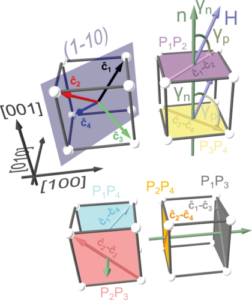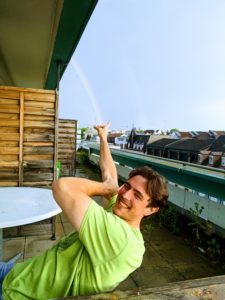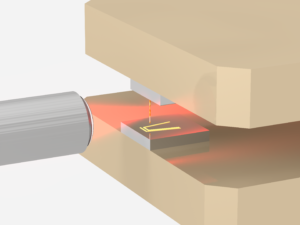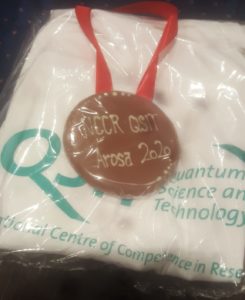2020 News
December 2020
Simon gives talk at JEMS
On the 7th, Ph.D. student Simon Philipp gave a talk at the Joint European Magnetic Symposia (JEMS) 2020 held remotely in Lisbon, Portugal. His talk was entitled, “Cantilever torque magnetometry on individual spherical Janus particles”.
November 2020
Paper on Soft X-ray Microscopy Published
On the 10th, Optica published a paper, on which we collaborated, entitled, Soft x-ray microscopy with 7 nm resolution. The manuscript discusses the combination of newly developed soft x-ray Fresnel zone plate lenses with advanced scanning control and careful optical design to achieve x-ray microscopy with a spatial resolution of 7 nm.
Our group’s contribution to this collaboration was made by post-doc Dr. Boris Groß, who did the micromagnetic simulations used to analyze and interpret the observations.
PhD Student Arrives
On the 1st, Andriani Vervelaki started as Ph.D. student in the group. Andriani comes to us from Crete University in Greece, where she earned her Bachelor of Science in 2018 and her Masters degree in 2020 in physics and photonics, respectively. Welcome Andriani!
October 2020
Nicola Rossi Moves On
Dr. Nicola Rossi, who started as a Ph.D. student in June 2014, graduated in July 2019, and stayed on as a post-doctoral researcher, left the group at the end of the month. After a short and well-deserved break, he will start work at AMS in Rüschlikon, Switzerland. Nicola has been a key member of the group for many years, performing the group’s first experiments with nanowire scanning probes, leading these efforts, and later providing crucial support to our SQUID-on-tip experiments. He will be sorely missed in the group. We wish him the best of luck in his next adventure and hope he won’t be a stranger!
Post-doc Starts Work
On the 6th, Dr. Kousik Bagani started work in our group as a post-doctoral researcher. Kousik earned his Bachelor of Science in Physics in 2008 from Panskura Banamali College at Vidyasagar University and his Masters of Science in Physics in 2010 from Jadavpur University, both in India. In 2016, he received his Ph.D. in Physics from the Saha Institute of Nuclear Physics at Calcutta University. There he wrote a thesis on “Role of Defects in Anomalous Change of Physical Properties in Graphitic and Oxide Nano-Materials” under the supervision of Prof. Sangam Banerjee. From 2017 to 2020, he worked as a post-doctoral researcher at the Weizmann Institute in Israel in the group of Prof. Eli Zeldov on developing the a new generation of nanometer-scale SQUID-on-tip sensors. Welcome Kousik!
FIBsuperProbes Now Underway
 On the 1st, our new FET Open collaborative project, entitled “Focused Ion Beam fabrication of superconducting scanning Probes” or FIBsuperProbes for short, had its official start. We are the lead and coordinating partner of a project, which includes with researchers from IBM Research in Zürich led by Dr. Armin Knoll, from the University of Tübingen led by Prof. Dieter Kölle, and from the Consejo Superior de Investigaciones Cientificas (CSIC) in Zaragoza led by Prof. Jose María De Teresa. We plan to develop a new method — based on forcused ion beam (FIB) technology — of fabricating nanometer-scale superconducting scanning probes. The FET Open provides nearly 3M EUR of research funds to the 4 partner groups over the course of 3.5 years. The collaboration’s website can be found here.
On the 1st, our new FET Open collaborative project, entitled “Focused Ion Beam fabrication of superconducting scanning Probes” or FIBsuperProbes for short, had its official start. We are the lead and coordinating partner of a project, which includes with researchers from IBM Research in Zürich led by Dr. Armin Knoll, from the University of Tübingen led by Prof. Dieter Kölle, and from the Consejo Superior de Investigaciones Cientificas (CSIC) in Zaragoza led by Prof. Jose María De Teresa. We plan to develop a new method — based on forcused ion beam (FIB) technology — of fabricating nanometer-scale superconducting scanning probes. The FET Open provides nearly 3M EUR of research funds to the 4 partner groups over the course of 3.5 years. The collaboration’s website can be found here.
September 2020
New Masters Student Starts
This month, Aurèle Kamber started work in our group as a Masters student working with Dr. Floris Braakman. Aurèle received his B.S. in Nanoscience with focus in Physics in 2019 from the University of Basel. Welcome!
New Post-doc Joins Group
On the 15th, Dr. Francesco Fogliano started work in our group as a post-doctoral researcher. Francesco earned his Bachelor of Science in Physics in 2012 and his Masters of Science in Physics in 2015, both from the University of Pisa. In 2019, he received his Ph.D. in Physics from the Néel Institute in Grenoble. There he worked on ultrasensitive nanowire force sensors at very low temperatures under the supervision of Dr. Olivier Arcizet, Dr. Benjamin Pigeau, and Dr. Jean-Philippe Poizat. Welcome Francesco!
Paper published on Stability of Néel-type Skyrmions
 On the 3rd, Phys. Rev. B published our paper entitled, Stability of Néel-type skyrmion lattice against oblique magnetic fields in GaV4S8 and GaV4Se8.
On the 3rd, Phys. Rev. B published our paper entitled, Stability of Néel-type skyrmion lattice against oblique magnetic fields in GaV4S8 and GaV4Se8.
The discovery of magnetic skyrmions has spurred renewed interest in non-centrosymmetric magnets. Their topologically protected spin-texture, which can be stable even at room temperature, their nanometer-scale size, and their easy manipulation via electric currents and fields make skyrmions a promising platform for information storage and processing applications.
Until recently, most investigations in bulk crystals have focused on Bloch-type skyrmions, in which the local magnetization rotates perpendicular to the skyrmion’s radial direction. Recently, however, Néel-type skyrmions, in which the local magnetization rotates parallel to its radial direction, have been observed in bulk GaV4S8, GaV4Se8, and GaMo4S8. These materials, which crystallize in the cubic lacunar spinel structure, are multiferroic and could enable nearly dissipation free manipulation of the skyrmions magnetic order by electric fields. In addition to having different spin textures and phase diagrams, the lack of a competing conical phase makes Néel-type skyrmions more robust than their Bloch-type counterparts.
The paper presents experiments, in which we use dynamic cantilever magnetometry (DCM) to map the magnetic phase boundaries in GaV4S8 and GaV4Se8 as a function of the strength and orientation of magnetic field. We determine the corresponding phase diagrams, which reproduce the major features predicted by a recent theoretical model. The measurements constitute a direct experimental confirmation of the robustness of Néel-type skyrmions to oblique magnetic fields in two materials with uniaxial magnetic anisotropy of opposite signs. In addition to magnetic transitions between the cycloidal, skyrmion lattice, and field-polarized ferromagnetic states, in GaV4Se8, we also observe sharp anomalies in the DCM, which we assign to field-driven transformations of magnetic states confined to polar domain walls (DWs).
Our work represents a new and original application of DCM to the study of magnetic skyrmions. It serves both as a template for future studies of skyrmion-hosting materials and provides new information about lacunar spinels and Néel-type skyrmions. In particular, the measured magnetic phase diagrams for GaV4S8 and GaV4Se8 are in good qualitative agreement with the theoretical predictions and provide insight for how to improve these initial models. Furthermore, the DCM measurements yield new evidence for distinct magnetic states confined to polar structural DWs and their transition from the Cyc to FM state.
The project represents a tight collaboration between our group, the group of István Kézsmárki from the University of Augsburg, Sándor Bordács from Budapest Univeristy, and Andrey Leonov from Hiroshima University. Our group contributed by making sensitive magnetic torque measurements at low temperature as a function of magnetic field magnitude and direction. Combined with information gained by the other experimental techniques, we were able to construct a complete picture of the sample’s magnetic states. Former Ph.D. student Dr. Andrea Mehlin did much of the early experiments and analysis along with Dr. Boris Groß. Ph.D. student Simon Philipp contributed to experiments in the later part of the project. In the final months of the project, Boris worked extensively on the data analysis and on creating a model with our collaborators that was consistent with all of the measurements.
August 2020
Machine Shop / Poggio Lab BBQ
On the 21st, we held our annual barbecue on the department’s roof-top with our colleagues from the Machine Shop. Despite having to hold a smaller event than usual, due to corona virus related restrictions, it was a fun and relaxing way to bid farewell to the summer holiday season. A special thanks to those who helped set up and clean up. See you next year!
July 2020
Annual BBQ at the Birsköpfli
On the 18th, group members and friends met up for for the 4th year at the Birsköpfli park along the Rhine river to relax, enjoy the sun, eat, drink, and cool off in the river. Thanks to all for making it out! Pictures are here.
Paper published in npj Quantum Materials
On the 6th, npj Quantum Materials published our paper on the lacunar spinel GaV4Se8 entitled, Macroscopic manifestation of domain-wall magnetism and magnetoelectric effect in a Néel-type skyrmion host. In it, we report on a magnetic state, which emerges exclusively in samples with mesoscale polar domains and not in polar mono-domain crystals. This state is manifested by a sharp anomaly in the magnetic susceptibility and the magnetic torque, distinct from other anomalies observed also in polar mono-domain samples upon transitions between the cycloidal, the Néel-type skyrmion lattice and the ferromagnetic states. We ascribe this additional transition to the transformation of distinct magnetic textures, confined to polar domain walls (DW), to the ferromagnetic (FM) state. The emergence of these DW-confined magnetic states is likely driven by the mismatch of different spin spirals, hosted by the adjacent domains. A clear anomaly in the magneto-current indicates that the DW-confined magnetic states also have strong contributions to the magnetoelectric response. We expect polar DWs to commonly host such confined magnetic edge states and, thus, offer a fertile ground to explore novel forms of magnetism.
The project was a collaboration between a variety of groups. Our group contributed by making sensitive magnetic torque measurements of GaV4Se8 at low temperature as a function of magnetic field magnitude and direction. Combined with information gained by the other experimental techniques, we were able to construct a complete picture of the sample’s magnetic states. Former Ph.D. student Dr. Andrea Mehlin did much of the early experiments and analysis along with Dr. Boris Groß. Ph.D. student Simon Philipp contributed to experiments in the later part of the project. In the final months of the project, Boris worked extensively on the data analysis and on creating a model with our collaborators that was consistent with all of the measurements.
June 2020
Party for Lorenzo
 On Friday the 19th, the group finally celebrated Dr. Lorenzo Ceccarelli’s successful Ph.D. defense in early May. We had been unable to do so because of rules instituted to curb the spread of Coronavirus. Now that most of these rules have been relaxed, we had a small barbecue on the roof of the Department. Thanks to Lorenzo for organizing and all those attending for a good time!
On Friday the 19th, the group finally celebrated Dr. Lorenzo Ceccarelli’s successful Ph.D. defense in early May. We had been unable to do so because of rules instituted to curb the spread of Coronavirus. Now that most of these rules have been relaxed, we had a small barbecue on the roof of the Department. Thanks to Lorenzo for organizing and all those attending for a good time!
Promotion to Full Professor
On Tuesday the 9th, the University announced that Prof. Poggio was promoted to Full Professor, effective in the fall semester of 2020. In 2009, he was appointed Assistant Professor with tenure-track and since 2014, he has been Associate Professor for Nanotechnology at the Department of Physics in the Faculty of Science.
May 2020
QSIT Zoom Seminar
On Thursday the 14th, Prof. Poggio gave an online seminar for a new series of teleconference seminars organized by the NCCR QSIT. The seminar was entitled, “Imaging weak magnetic field patterns on the nanometer-scale” and can be found here.
Lorenzo Ceccarelli Earns Ph.D.
On Friday the 8th, Ph.D. student Lorenzo Ceccarelli defended his thesis, entitled “Scanning probe microscopy with SQUID-on-tip sensor”, earning his doctorate in Physics magna cum laude. The exam was chaired by Prof. Christoph Bruder with Prof. Poggio and Prof. Jose María De Teresa (Zaragoza) making up the committee. Lorenzo joined the lab as a Ph.D. student in January 2016 to work on the development and application of scanning SQUID-on-tip sensors. He was the first student to work on this project full time and carried out our first two experiments using this technique. The first was show the presence of flux-closure configurations in individual ferromagnetic nanotubes. The second investigated superconducting vortex dynamics and pinning in an amorphous superconducting film of MoSi.
Due to the restrictions due to the Coronavirus pandemic, the defense was carried out largely by teleconference. Unfortunately, this prevented the group from properly celebrating Lorenzo’s accomplishments. Given that he is staying on as a post-doctoral researcher, hopefully we will soon get a chance to throw him an appropriate party. Congratulations to Dr. Ceccarelli!
Masters Student to Start as Ph.D.
Lukas Schneider completed his Masters thesis in our lab at the beginning of this month on, “Scanning probe microscopy with lasing nanowires”. After a short break from the group to complete his civil service, Lukas will start on July 1st in the group as a Ph.D. student. His position is funded by by the Swiss Nanoscience Institute through their Ph.D. School on a project entitled, “Magnetic force microscopy with nanowire transducers”.
New FET Open Project Approved
 Our group recently won an FET Open project grant under the European Commission’s Horizon 2020 program. This funding scheme supports European collaborations aimed at developing radically innovative technologies. We will be the lead partner in a project entitled, “Focused Ion Beam fabrication of superconducting scanning Probes (FIBsuperProbes)”. Working with researchers from IBM Research in Zürich, the University of Tübingen, and the Consejo Superior de Investigaciones Cientificas (CSIC) in Zaragoza, we plan to develop a new method — based on forcused ion beam (FIB) technology — of fabricating nanometer-scale superconducting scanning probes. Starting in October 2020, the FET Open will provide nearly 3M EUR of research funds to the 4 partner groups over the course of 3.5 years. See here for a write-up.
Our group recently won an FET Open project grant under the European Commission’s Horizon 2020 program. This funding scheme supports European collaborations aimed at developing radically innovative technologies. We will be the lead partner in a project entitled, “Focused Ion Beam fabrication of superconducting scanning Probes (FIBsuperProbes)”. Working with researchers from IBM Research in Zürich, the University of Tübingen, and the Consejo Superior de Investigaciones Cientificas (CSIC) in Zaragoza, we plan to develop a new method — based on forcused ion beam (FIB) technology — of fabricating nanometer-scale superconducting scanning probes. Starting in October 2020, the FET Open will provide nearly 3M EUR of research funds to the 4 partner groups over the course of 3.5 years. See here for a write-up.
Masters Student Starts Work
This month, Mathias Claus started work as a Masters Student working on ultra-sensitive sensors for torque magnetometry. Mathias received his Bachelor of Science in Nanoscience in 2019 from the University of Basel. He joins the group after doing one of his Masters works on a related project.
April 2020
Paper on MFM using nanowires fabricated by FEBID
 On the 16th, Physical Review Applied published our paper entitled, Nanowire magnetic force sensors fabricated by focused-electron-beam-induced deposition. The manuscript demonstrates the use of individual magnetic nanowires (NWs), grown by focused-electron-beam-induced deposition (FEBID), as scanning magnetic force sensors. Our measurements of their mechanical susceptibility, thermal motion, and magnetic response show that these NWs possess high-quality flexural mechanical modes and a strong remanent magnetization pointing along their long axis. Together, these properties make the NWs excellent sensors of weak magnetic field patterns, as confirmed by calibration measurements on a micron-sized current-carrying wire and magnetic scanning-probe images of a permalloy disk. The flexibility of FEBID in terms of the composition, geometry, and growth location of the resulting NWs, makes it ideal for fabricating scanning probes specifically designed for imaging subtle patterns of magnetization or current density.
On the 16th, Physical Review Applied published our paper entitled, Nanowire magnetic force sensors fabricated by focused-electron-beam-induced deposition. The manuscript demonstrates the use of individual magnetic nanowires (NWs), grown by focused-electron-beam-induced deposition (FEBID), as scanning magnetic force sensors. Our measurements of their mechanical susceptibility, thermal motion, and magnetic response show that these NWs possess high-quality flexural mechanical modes and a strong remanent magnetization pointing along their long axis. Together, these properties make the NWs excellent sensors of weak magnetic field patterns, as confirmed by calibration measurements on a micron-sized current-carrying wire and magnetic scanning-probe images of a permalloy disk. The flexibility of FEBID in terms of the composition, geometry, and growth location of the resulting NWs, makes it ideal for fabricating scanning probes specifically designed for imaging subtle patterns of magnetization or current density.
Ph.D. student Hinrich Mattiat led the research and carried out the experiments in collaboration with Dr. Nicola Rossi. Dr. Boris Groß developed and ran the micromagnetic simulations. Collaborators from the University of Zaragoza fabricated the magnetic NWs by FEBID, while collaborators from Case Western University fabricated the permalloy micro-disks used as demonstration samples.
Book Chapter on Magnetic Nanotubes
On the 1st, Elsivier published the second edition of a book entitled, Magnetic Nano- and Microwires: Design, Synthesis, Properties and Applications, edited by Prof. Manuel Vázquez. Chapter 17, which is written by Prof. Poggio, is entitled, Determining magnetization configurations and reversal of individual magnetic nanotubes. It focuses on ferromagnetic nanotubes (FNTs) and their experimental investigation by techniques capable of measuring the response of individual specimens. This capability has been developed recently and is now having a strong impact on our understanding of the behavior of real FNT structures. The chapter reviews measurements of magnetoresistence, torque magnetometry, X-ray microscopy, scanning SQUID microscopy, and magnetic force microscopy.
March 2020
Reduced Operations due to Public Health Emergency
Because of the world-wide public health emergency, the University of Basel, the Department of Physics, and our group have been gradually scaling back operations over the last month. All seminars, conferences, and travel have been cancelled. Since the 22nd, the department and our lab are operating under emergency rules. Only critical experiments continue in our labs under strict social distancing rules, while group members work from home as much as possible.
February 2020
Estefani Wins Post-doc Award
On Friday the 7th, post-doctoral researcher Dr. Estefani Marchiori won a QSIT INSPIRE Postdoc Award. This competitive award recognizes outstanding female scientists at the post-doc level within the QSIT network. The award includes a 10k CHF grant for travel and small equipment expenditures. Congratulations Estefani!
Thibaud Skis to Second Consecutive QSIT Victory
 On Thursday the 6th, Ph.D. student Thibaud Ruelle won the annual QSIT ski race in at the NCCR QSIT General Meeting in Arosa, Switzerland for the second year in a row. Just like last year, Thibaud predicted victory and mercilessly crushed the competition. Congratulations again!
On Thursday the 6th, Ph.D. student Thibaud Ruelle won the annual QSIT ski race in at the NCCR QSIT General Meeting in Arosa, Switzerland for the second year in a row. Just like last year, Thibaud predicted victory and mercilessly crushed the competition. Congratulations again!
Group at Arosa Winter School and General Meeting
From the 3rd to the 7th, members of the group attended the 9th NCCR Winter School and 10th NCCR QSIT General Meeting in Arosa, Switzerland. Masters students Lukas Schneider and Arsalan Saeedi attended the school from Monday to Wednesday, while Ph.D. students Hinrich Mattiat, Lorenzo Ceccarelli, Giulio Romagnoli, Thibaud Ruelle, post-doc Dr. Estefani Marchiori, and Prof. Poggio attended the meeting from Wednesday to Friday. Dr. Floris Braakman also attended the meeting in his role as senior scientist in the Zumbühl group. Hinrich, Lukas, and Thibaud presented posters on their work. Thanks to Klara Berg of QSIT for organizing another successful meeting.
January 2020
Nanoskyrmionics Ski Retreat
From the 28th to the 30th, our Nanoskyrmionics Sinergia Network held a ski retreat a “Zschokke Haus” chalet of the University of Basel, located on Gerschni Alp at the foot of Mt. Titlis in Engelberg, Switzerland. The event was an opportunity for skiing, scientific discussions, and socializing between network members. Post-doc Dr. Boris Groß and Ph.D. student Simon Philipp from our group were in attendance. Special thanks to Simon for helping to organize the event.
News & Views in Nature Physics
On Wednesday the 8th, Nat. Phys. published a commentary piece by Prof. Poggio and post-doctoral researcher Dr. Nicola Rossi entitled, Currents cool and drive, discussing two recent papers describing electromechanical experiments in suspended carbon nanotubes. In particular, the piece highlights recent work showing that electrons driven through a suspended carbon nanotube by a constant bias excite mechanical vibrations — including self-sustaining oscillations — and, in some cases, even suppress them down to only a few quanta. The experiments in question are described in papers by Adrian Bachtold and colleagues and by Edward Laird and colleagues.
New Masters Student Starts
On Tuesday the 7th, Daniel Jetter started work in our lab as a visiting Masters student. Daniel received his Bachelor of Science from the University of Tübingen in 2019. He will pursue his Masters project on scanning nanometer-scale SQUID microscopy in our lab, while continuing to be enrolled as a student of the University of Tübingen. Prof. Reinhold Kleiner in Tübingen will serve as his Masters advisor and Prof. Poggio will host the project.
